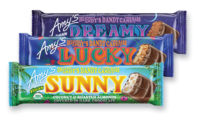![]()
Candy’s Still Dandy, But…
by Dana Cvetan
|
Non-chocolate purveyors are responding to growing
weight, health concerns and also dreaming up new creamy flavors.
There’s no denying consumers’ pervasive, at times near-obsessive,
worry over expanding waistlines and their effect on health and well-being. In
the non-chocolate arena, confectionery manufacturers are stepping up to respond
in a number of ways — by introducing products formulated to be lower in carbohydrate
counts as well as by pumping up promotion of offerings that already are low
in carbs. Vendors also are fortifying candy with health-advancing vitamins and
minerals.
Jelly Belly Candy Co., Fairfield, Calif., has reformulated its
sugar-free Jelly Belly and Jelly Belly Sours to reduce calories and carbohy-drates.
“Nobody has a crystal ball…but (carb
counting) is definitely a trend, and we want consumers to continue to enjoy
our products, so we responded,” says Pete Healy, Jelly Belly’s
vice president of marketing and international sales.
Jelly Belly also plans to expand its sugar-free
offerings. “We are bringing to market a range of our confectionery
items in new sugar-free, low-carb formulations — spice drops, gummy
cola bottles and fruit slices,” Healy reports.
“People may be counting carbs, but there is
always a little bit of room for something sweet, as long as it’s
worth it,” says Cindy Brooks, product manager for Adams & Brooks
Inc., Los Angeles. Adams & Brooks is introducing a reformulation of one
of its popular lines, sugar-free Coffee Rio Lo Carb hard coffee candy in
original, espresso and latte flavors.
It behooves the manufacturers of sugar-free candies to remind
consumers they have been making low-carb candy all along, Susan Rosenthal Jay,
vice president of marketing for Hillside Candy, Hillside, N.J., points out.
“Since 1980, our candy has always had zero net carbs – we were
one of the first – so we are proudly stating that on our bags,” she says. “You
can’t miss them,” says Jay.
Vitech America, Kent, Wash., is also advertising on its mint and candy tins that they are sugar-free and low-carb.
Vitech America, Kent, Wash., is also advertising on its mint and candy tins that they are sugar-free and low-carb.
Even though the fat-free era may have passed,
consumers are still aware how important it can be to limit fat intake, Jay
adds. Consumers “have sensitivity to eating better than they have
been.” Hillside is the exclusive U.S. distributor of My Favorite
Candies, endorsed by supermodel Heidi Klum and manufactured by German candy
maker Katjes. The line is fat-free, made with yogurt and apple pulp for
flavor and chewy texture, and though it contains sugar, is positioned as a
“good-for-you” product.
Atlanta-based Chupa Chups U.S.A., is differentiating itself
by fortifying some lollipops with vitamins and minerals, making some sugar-free
and adding other functionalities to its products, reports Kevin Foltz, marketing
manager. As part of its effort to position itself as a “healthier” lollipop
company, Chupa Chups also secured the endorsement of star soccer player and
Olympic Gold Medal winner Mia Hamm.
Chupa Chups has also added Vitamin C to its Crazy Dips candy
for kids. Its Smint brand mints contain Zylitol, a natural sugar substitute
that helps reduce the mouth bacteria that can cause plaque buildup, plus papaya-derived
Papin enzymes to whiten teeth.
Refined sugar is gone from Innovative Candy
Concepts’ Too Tarts kids’ line. Reformulated and re-named Too
Tarts SmartChoice, the candies are sweetened with the company’s own
fruit juice concentrate blend, called Jammy Juice, and small amounts of
sucralose, glycerin and Acesulfame K. The reformulation reduced calorie
content 50 to 60 percent.
“There’s a major wake up call to
manufacturers of consumable products that things have to change,”
asserts Armand Hammer, president and CEO of Atlanta-based Innovative Candy
Concepts.
“What they did yesterday will not take them into
the future and they have to reexamine what they are doing,” says
Hammer. “ All these adults are getting educated and changing their
eating habits, but they’ve got kids, they’ve got grandkids,
eating all this stuff made with high fructose corn syrup. If you can
make candy in a healthy, positive way, isn’t that better? Technology
changes every day and more and more materials become available, so not only
can you make a healthier candy, you can make it taste better,” he
says.
Hammer believes the low-carb trend will moderate. “There’s nothing
wrong with refined sugar, the problem is, it’s in everything. The problem is
the huge amounts people eat.”
Flavor trends
In non-chocolate candy flavorings, “the mega-trend over the
last two years is creamy — consumers really know us for creamy flavors,” says
Chupa Chups’ Foltz. “Strawberry and cream is one of our more indulgent creamy
flavors, and we’ve added strawberry yogurt and peach yogurt,” to the flavor
line-up.
“Definitely cream, that’s continuing,” agrees Hillside’s Jay.
Hillside’s new line, My Favorite Candy, also features several creamy, yogurt-based flavors.
Fruit flavors, especially citrus, whether alone or paired with creamy tastes, are gaining favor with the public.
“You’re going to see a lot of fruity flavors getting more popular, and fruit and cream flavors are very popular,” says Katherine Owens, vice president of business development for Rockville, Md.-based Sherwood Brands.
“We see growing interest in, and influence of flavors that come from the Hispanic culture and heritage,” observes Jelly Belly’s Healy. An example is the growing popularity of tamarind, he says.
Hillside is on this trend — coming out with a tropical fruit mix in its Golightly hard candy, Jay reports.
“Definitely cream, that’s continuing,” agrees Hillside’s Jay.
Hillside’s new line, My Favorite Candy, also features several creamy, yogurt-based flavors.
Fruit flavors, especially citrus, whether alone or paired with creamy tastes, are gaining favor with the public.
“You’re going to see a lot of fruity flavors getting more popular, and fruit and cream flavors are very popular,” says Katherine Owens, vice president of business development for Rockville, Md.-based Sherwood Brands.
“We see growing interest in, and influence of flavors that come from the Hispanic culture and heritage,” observes Jelly Belly’s Healy. An example is the growing popularity of tamarind, he says.
Hillside is on this trend — coming out with a tropical fruit mix in its Golightly hard candy, Jay reports.
Sour is still hot, and is expanding rapidly to older
age groups, “but they are looking for the softer flavors, not the
intense sours, and citrus flavors are dominant,” says Rich
Clemmensen, vice president of marketing for Azusa, Calif.-based Morris
National Inc.
Morris has introduced some sophisticated flavors in its new
Zip Sours brand of hard candy that takes a new direction in sours. Aimed primarily
at young adults and adults, but also teenagers, Zip Sours feature natural flavoring
and coloring in Ruby Red Grapefruit, Mandarin Orange, Cranberry and Black Cherry.
The sour flavors are “softer, lighter and milder, which is more refreshing,”
he says.





